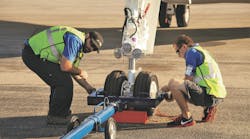Phoenix Sky Harbor is a city-owned and operated airport; Baltimore-Washington, on the other hand, is owned by the state and is part of a much larger transportation dynamic, just miles from Ronald Reagan National and Dulles.
The retail and concession developments at both facilities centered around their major carriers: at PHX, it was for America West; at BWI, for Southwest. Those developments in turn became part of larger upgrade initiatives. At PHX, it’s the renovation and retail upgrade at Terminal 2. For BWI, it’s the upgrade of all remaining retail as well as a facelift for its well-recognized metal and glass facade.
In the case of Phoenix, outgoing Airports Council International -North America president David Plavin, speaking on the subject of new funding alternatives for U.S. airports, recently told AIRPORT BUSINESS, “You can go to a Phoenix model, where they have a tariff on every different kind of use at the airport – gate utilization; holding room utilization; baggage; a whole series of things. Individual charges for individual uses. They’re doing just fine. Each year, their city council passes an ordinance on the tariff.”
Comments PHX business development manager Paula Kucharz, “One of our guiding principles is competition.” At BWI, explains director Paul Wiedefeld, “We were never going to have the BWI staff to do this; we didn’t have the expertise on board. That’s why we hired BAA. What we’ve done is direct them, particularly as it pertains to a strong local component. Plus, we wanted more international brands, considering the demographics of the Baltimore-D.C. area.”PHX - Terminal 4
Sky Harbor’s Terminal 4 redevelopment project is centered around America West and Southwest, among other carriers. The terminal alone accounts for some 75 percent of total airport passenger traffic, according to officials. Along with the Terminal 2 upgrade currently underway (16 stores to 43), the projects are transforming retail/concessions at PHX. As Kucharz indicates, how shops are configured is sculpted around competition. Unlike the BWI model which has an overall contractor/manager, Phoenix has decided to directly handle most of the leasing arrangements.
Explains Kucharz, “The guiding principle of competition follows through in our RFP [request for proposal] process and everything else. We do the RFP process in three phases, while taking into account construction, listening to retailers.
“They voiced a concern about one person winning everything, and getting one chance only. So when we looked at the construction schedule, we developed an RFP process in three phases.”
The result, she says, was putting the properties in bundles of — at most — three locations. “We issued the RFP as one document that included everything, but with phases,” she says.
“We looked at how do you capture the most sales; how do we give the most variety to passengers; and, how do we help to give the retailers good, solid contracts.”
Kucharz explains that every bundle is linked, airside/landside. “If you’ve got something in the lobby, you’ve got something on the concourse,” she says. “We were in effect exposing the passengers to variety while giving the people we contract with the most opportunity.”
“That was a guiding factor in how we developed the bundles.”
BWI - Southwest Terminal
Meanwhile, at BWI, a desire to keep the size of administrative staff at reasonable levels and customer input that indicated an interest in more international shops, led to the decision to contract with BAA.
In May, BAA opened some 25,000 square feet of retail space, highlighted by the debut of the new Southwest Terminal. The carrier accounts for about half of BWI airline operations. Explains Mark Knight, BAA USA VP and regional director, “It’s in line with our developments with name brands — but all are owned locally. We like to get that blend of national and international names, with strong local participation.
“Looking at the airport project as a whole, we’ll have around 50 percent of our sales from minority or DBE [disadvantaged business enterprise] participants.” Over the next 18 months, he explains, BAA will be systematically redeveloping the remaining retail space in the original terminal areas.
Comments Wiedefeld, “BAA has been here only ten months and already opened the new terminal in May. They had to move quickly. Now they’re turning their focus to the older facility.”
BAA’s contract, says Wiedefeld, is for 12 years — two years to cover the redevelopment phase; then a standard ten-year contract.





